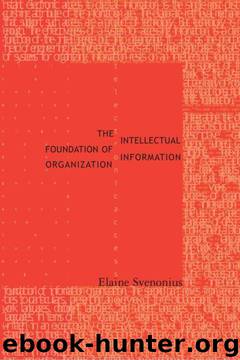The Intellectual Foundation of Information Organization (Digital Libraries and Electronic Publishing) by Elaine Svenonius

Author:Elaine Svenonius
Language: eng
Format: epub
Published: 2012-06-16T02:42:00+00:00
Publisher
Persons and agencies involved in making a document public include publishers, distributors, producers, manufacturers, and release agents. A publisher is a person or agency by whose authority a document is made public. A distributor is one from whom copies of a document can be obtained. A producer is the person or agency that finances a document, supervises its making, and makes it public. A manufacturer is the one who constructs it. And a release agent is one who makes an unpublished document available for circulation." The names of some or all of these may appear in bibliographic descriptions.
Even for traditional materials it can be difficult to identify a publisher, as when a document is printed for W, under the aegis of X, supported by Y, and distributed by Z. Sometimes it is difficult to distinguish the publisher of a document from its originator or author. In the online environment identification problems are exacerbated. (Is the person or agency that maintains an Internet list considered to be a publisher?)14 A Machine Readable Bibliographic Information (MARBI) committee discussion paper suggests dividing the variety of people involved in the creating, organizing, and making accessible an electronic resource into two groups: producers and distributors. 15 It defines a producer as the person or agency who organizes the resource and is responsible for it as a whole. It defines a distributor as the one who makes an electronic document available online. It is not clear how often in the electronic environment these distinctions are actual, since frequently the same entity performs all the functions of authoring, producing, and distributing. Most difficult of all, perhaps, is not being able to tell, by looking at the names on a document, who does what. The publishers of online documents are not bound by the same protocols as their offline counterparts. It is not unusual for electronic documents to lack formal publisher statements. When this is the case, bibliographic guidelines suggest that an attempt be made, using internal or external evidence, to infer a publisher.', The ISO 690-2 guideline for citing electronic documents suggests that if a publisher is unknown to record instead a network address.17 But this will not do for AACR-type description, which unlike citation description, must shoulder the burden of bibliographic control.
Download
This site does not store any files on its server. We only index and link to content provided by other sites. Please contact the content providers to delete copyright contents if any and email us, we'll remove relevant links or contents immediately.
Cecilia; Or, Memoirs of an Heiress — Volume 1 by Fanny Burney(31353)
Cecilia; Or, Memoirs of an Heiress — Volume 3 by Fanny Burney(30951)
Cecilia; Or, Memoirs of an Heiress — Volume 2 by Fanny Burney(30908)
The Great Music City by Andrea Baker(21633)
We're Going to Need More Wine by Gabrielle Union(18088)
Bombshells: Glamour Girls of a Lifetime by Sullivan Steve(13120)
Pimp by Iceberg Slim(12948)
All the Missing Girls by Megan Miranda(12776)
Fifty Shades Freed by E L James(12464)
Talking to Strangers by Malcolm Gladwell(11909)
Norse Mythology by Gaiman Neil(11903)
Crazy Rich Asians by Kevin Kwan(8373)
Mindhunter: Inside the FBI's Elite Serial Crime Unit by John E. Douglas & Mark Olshaker(7850)
The Lost Art of Listening by Michael P. Nichols(6485)
Enlightenment Now: The Case for Reason, Science, Humanism, and Progress by Steven Pinker(6416)
Bad Blood by John Carreyrou(5784)
The Four Agreements by Don Miguel Ruiz(5533)
Weapons of Math Destruction by Cathy O'Neil(5049)
We Need to Talk by Celeste Headlee(4881)
